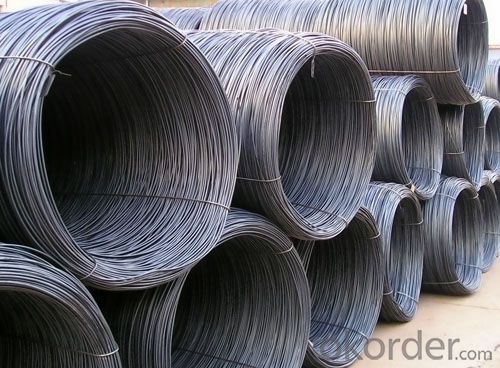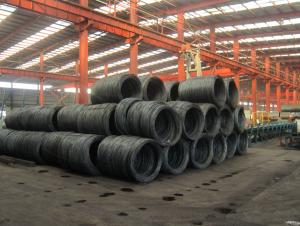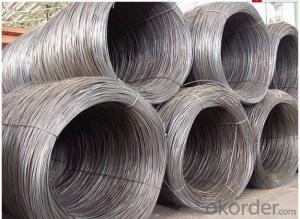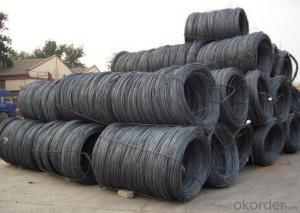GB Standard-Q195Steel Wire Rod with High Quality
- Loading Port:
- China Main Port
- Payment Terms:
- TT or LC
- Min Order Qty:
- 40 m.t
- Supply Capability:
- 15000 m.t/month
OKorder Service Pledge
OKorder Financial Service
You Might Also Like
Product Description:
Specifications of GB Standard-Q195Steel Wire Rod with High Quality:
Steel Grade: Q195 Standard:GB
Diameter: 6.5mm
6.5mm can be drawing into 2mm/8.0mm can be drawing into 3mm
Each coil weight about 2MT
Chemical Composition:
Please kindly find our chemistry of our material based on Q195 as below for your information
Trademark | Rank | Chemical composition (quality score) % | |||||
C | Si | Mn | S | P | |||
| ≤ |
| ≤ | ≤ | |||
Q195 |
| 0.06-0.12 | 0.30 | 0.25 | 0.050 | 0.045 | |
Trademark | Rank | Pulling Test | |||||
Bend PointΔs/Mpa | Tensile Strength | Elongation Ratioδ5% | |||||
Thickness (Diameter) /MM | Thickness (Diameter) /MM | ||||||
≤16 | 16-40 | ≤16 | 16-40 | ||||
≥ | ≥ | ||||||
Q195 |
| 195 | 185 | 315-390 | 33 | 32 | |
Usage and Applications of GB Standard-Q195Steel Wire Rod with High Quality:
After hot-rolled the products shaped into coil and delivery as finished product, including round, square, rectangular, hexagonal and so on. Since most of the products are round, it is generally called wire rod. Carbon steel wire rod is widely used in construction and manufacturing. Carbon steel wire rod is mainly used for reinforcement of reinforced concrete and welded structure or reprocessed (roberts , nail, etc.) materials, especially used to produce wire drawing, welding electrode, nails, spring, electronic, precise machinery parts and so on.
Production Process of GB Standard-Q195Steel Wire Rod with High Quality:
Steel billet---Heating---Rolling---Water-cooling---Coiling---Cooling---Inspection---Bundling---Exworks
Packaging & Delivery of GB Standard-Q195Steel Wire Rod with High Quality:
Packaging Detail: products are packed in coil and then shipped by container or bulk vessel
Each coil weight: About 2MT
Delivery Detail: within 45 days after received deposit or LC.
Label: to be specified by customer, generally, each bundle has 1-2 labels
Trade terms: FOB, CFR, CIF
FAQ:
Q1: How soon can we receive the product after purchasement?
A1: Within three days of placing an order, we will begin production. The specific shipping date is dependent upon international and government factors, but is typically one month.
Q2: How do you guarantee the quality of our products?
A2: We have established an advanced quality management system which conducts strict quality tests at every step, from raw materials to the final product. At the same time, we provide extensive follow-up service assurances as required.
Q3: The prices are invoicing on theoritical weight or on actual weight?
A3: We can do it in both manners, according to the customers' request.
Images of GB Standard-Q195Steel Wire Rod with High Quality:


*If you would like to get our price, please kindly inform us the size, standard/material and quantity. Thank you very much for your attention.
- Q:How is steel wire rod used in the manufacturing of wire for aerospace applications?
- Steel wire rod is a crucial component in the manufacturing of wire for aerospace applications. The wire rod serves as the primary raw material for producing high-quality wires that are specifically designed to meet the demanding requirements of the aerospace industry. Firstly, the steel wire rod undergoes a series of processes such as cleaning, descaling, and heat treatment to enhance its mechanical properties and ensure its purity. These processes help in removing any impurities or contaminants that may affect the wire's performance or structural integrity. Once the steel wire rod is prepared, it is then drawn through a series of dies to reduce its diameter and increase its length. This drawing process is performed multiple times to achieve the desired wire thickness and strength. The wire is carefully monitored during this process to maintain its dimensional accuracy and ensure consistent quality. After the wire has been drawn to the required size, it undergoes further treatments such as annealing or stress relieving to improve its ductility and resistance to fatigue. These treatments are essential in aerospace applications where the wire will be subjected to extreme forces and temperature variations. The manufactured wire is then subjected to rigorous testing and quality control measures to ensure it meets the stringent standards set by the aerospace industry. These tests include checking the wire's mechanical properties, surface finish, and dimensional accuracy. Once the wire passes all the necessary tests, it is ready to be used in various aerospace applications. Steel wire manufactured from wire rod is commonly used in aircraft control cables, wiring harnesses, fasteners, springs, and other critical components. The wire's high strength, durability, and resistance to corrosion make it suitable for withstanding the demanding conditions of aerospace environments. In summary, steel wire rod plays a vital role in the manufacturing of wire for aerospace applications. It undergoes various processes to enhance its properties, undergoes drawing and treatment processes to achieve the desired wire dimensions and strength, and is thoroughly tested to ensure it meets aerospace standards. The resulting wire is then used in critical aerospace components, contributing to the overall safety and performance of aerospace systems.
- Q:How is steel wire rod used in the manufacturing of wire forms for power lines?
- Steel wire rod is used in the manufacturing of wire forms for power lines as it serves as the raw material for producing high-strength, durable and conductive wires. The wire rod is first drawn through a series of dies to reduce its diameter and increase its strength, resulting in a wire with the desired characteristics for power transmission. These wires are then further processed and shaped into various wire forms, such as conductors and cables, which are used for overhead power lines to efficiently transmit electricity over long distances.
- Q:How is steel wire rod used in the production of wire mesh for architectural applications?
- Steel wire rod is commonly used in the production of wire mesh for architectural applications due to its strength and durability. The wire rod is first drawn into the desired diameter and then woven or welded together to form the wire mesh. This mesh is then utilized in various architectural applications such as fencing, partitions, and decorative screens. The steel wire rod provides the necessary structural integrity and stability to the wire mesh, making it a reliable choice for architectural designs.
- Q:How is steel wire rod used in the manufacturing of wire for suspension cables?
- Steel wire rod is a crucial component in the manufacturing of wire for suspension cables. Suspension cables are used in various applications such as bridges, cranes, and even elevator systems. The process of manufacturing wire for suspension cables involves several steps, and steel wire rod plays a critical role in each of these steps. Firstly, the steel wire rod is selected based on its quality and strength properties. It needs to have high tensile strength and excellent ductility to withstand the immense loads and forces that suspension cables are subjected to. The wire rod undergoes a thorough inspection to ensure it meets the required specifications. Next, the steel wire rod is processed through a series of mechanical operations. It is first cleaned and descaled to remove any impurities or surface contaminants. Then, it is heated to a suitable temperature for the subsequent wire drawing process. Heating the wire rod makes it more malleable and easier to deform. After the wire rod is heated, it is drawn through a series of dies to reduce its diameter and increase its length. This wire drawing process involves pulling the heated wire rod through progressively smaller dies, which elongates and thins the wire. This step is crucial in achieving the desired diameter and mechanical properties of the wire. Once the wire has been drawn to the required size, it is further processed to improve its surface finish and mechanical properties. This may involve processes such as annealing, where the wire is heated and slowly cooled to relieve internal stresses and improve its ductility. Finally, the wire is coated or galvanized to enhance its corrosion resistance and protect it from environmental factors. This coating not only improves the longevity of the suspension cables but also enhances their aesthetic appearance. In summary, steel wire rod is used in the manufacturing of wire for suspension cables through a series of mechanical operations. Its high tensile strength and ductility make it suitable for withstanding the heavy loads and forces that suspension cables experience. The wire rod undergoes processes such as cleaning, heating, wire drawing, and coating to achieve the desired diameter, surface finish, and mechanical properties. The end result is a high-quality wire that can be used in various suspension cable applications.
- Q:What are the different types of steel wire rod surface defect repair and rework procedures?
- There are several types of steel wire rod surface defect repair and rework procedures, depending on the specific defect and its severity. Some common procedures include grinding, polishing, and buffing to remove minor surface imperfections such as scratches or roughness. For more significant defects like cracks or dents, welding or brazing may be used to repair the damaged area. In some cases, the wire rod may need to undergo a complete rework process, involving cutting and reshaping the affected section, followed by heat treatment to restore its mechanical properties. Overall, the type of repair procedure used depends on the nature of the defect and the desired quality of the final product.
- Q:How is steel wire rod used in the manufacturing of wire forms for pet enclosures?
- Steel wire rod is an essential component in the manufacturing of wire forms for pet enclosures. This type of rod is typically made from high carbon steel, which provides excellent strength and durability. To create wire forms for pet enclosures, the steel wire rod is first processed through a series of machines that stretch and shape it into the desired wire thickness and length. This process, known as drawing, ensures that the wire is uniform and free from defects. Once the wire is ready, it is then bent and formed into various shapes and sizes to create the wire forms for pet enclosures. These wire forms can include panels, gates, and frames that are used to construct the enclosure. The use of steel wire rod in the manufacturing of wire forms for pet enclosures offers several benefits. Firstly, steel is a highly durable material that can withstand the wear and tear associated with pet activities. It is also resistant to rust and corrosion, ensuring that the wire forms remain in good condition even when exposed to various weather conditions. Additionally, steel wire rod provides the necessary strength and stability required to secure pets within the enclosures. This is crucial for ensuring the safety and security of the animals. The rigidity of the steel wire prevents pets from breaking or bending the wire forms, keeping them contained and protected. Furthermore, the versatility of steel wire rod allows for customization and flexibility in the design of wire forms. Manufacturers can create wire forms in different shapes, sizes, and configurations to cater to the specific needs of pet owners and their pets. In conclusion, steel wire rod plays a vital role in the manufacturing of wire forms for pet enclosures. Its strength, durability, and versatility make it an ideal material for creating secure and long-lasting enclosures for pets.
- Q:How is steel wire rod used in the production of wire shelves and racks?
- Steel wire rod is an essential component in the production of wire shelves and racks. It serves as the primary material from which the wire shelves and racks are constructed. Firstly, the steel wire rod is processed and drawn to achieve the desired shape and size for the wire shelves and racks. This process involves passing the wire rod through a series of dies and rollers to transform it into a thinner and more malleable wire form. Once the wire is drawn, it is then bent, cut, and welded to create the necessary components of the wire shelves and racks. The wire rods are shaped into grids, frames, and supports, which form the basic structure of the shelves and racks. The wire rods are also used to create the mesh or grid patterns that make up the shelving surfaces. These grids allow for the storage of various items without the risk of them falling through the gaps. Furthermore, the steel wire rod provides strength and durability to the wire shelves and racks. Its high tensile strength ensures that the shelves can withstand heavy loads without bending or breaking. This makes them suitable for industrial use where heavy items need to be stored. In addition, the steel wire rod is often coated or galvanized to enhance its corrosion resistance. This coating protects the wire shelves and racks from rust and other forms of degradation, thereby prolonging their lifespan and maintaining their appearance. Overall, the use of steel wire rod in the production of wire shelves and racks is crucial. It provides the necessary strength, durability, and functionality required for effective storage solutions in various settings, including homes, offices, warehouses, and retail spaces.
- Q:What are the common production processes for tool steel wire rod?
- The common production processes for tool steel wire rod include melting and refining the steel, casting the molten steel into billets or ingots, hot rolling the billets or ingots to reduce their thickness and shape them into wire rod, and finally, heat treating the wire rod to achieve the desired hardness and other properties.
- Q:What are the common industry guidelines for steel wire rod suppliers?
- The common industry guidelines for steel wire rod suppliers typically include ensuring consistent product quality, meeting international standards and specifications such as ASTM or ISO, adhering to safety and environmental regulations, providing timely delivery and reliable customer service, and maintaining competitive pricing.
- Q:How is steel wire rod used in the production of wire for mesh filters?
- Steel wire rod is used as the primary raw material in the production of wire for mesh filters. The wire rod is first drawn through a series of dies to reduce its diameter and increase its length. This process, known as wire drawing, results in a thinner and longer wire that is then woven or welded to create the mesh filter. The high strength and durability of steel wire rod make it an ideal material for manufacturing wire mesh filters, as it provides excellent filtration capabilities and can withstand harsh conditions.
1. Manufacturer Overview |
|
|---|---|
| Location | |
| Year Established | |
| Annual Output Value | |
| Main Markets | |
| Company Certifications | |
2. Manufacturer Certificates |
|
|---|---|
| a) Certification Name | |
| Range | |
| Reference | |
| Validity Period | |
3. Manufacturer Capability |
|
|---|---|
| a)Trade Capacity | |
| Nearest Port | |
| Export Percentage | |
| No.of Employees in Trade Department | |
| Language Spoken: | |
| b)Factory Information | |
| Factory Size: | |
| No. of Production Lines | |
| Contract Manufacturing | |
| Product Price Range | |
Send your message to us
GB Standard-Q195Steel Wire Rod with High Quality
- Loading Port:
- China Main Port
- Payment Terms:
- TT or LC
- Min Order Qty:
- 40 m.t
- Supply Capability:
- 15000 m.t/month
OKorder Service Pledge
OKorder Financial Service
Similar products
New products
Hot products
Related keywords




























